by scott.gillum | Sep 3, 2015 | 2015, Marketing
Just when we’ve convinced the organization that the key to our marketing communication success is personalized content, new research from CEB highlights that we actually may be doing more harm than good.
The years spent improving our understanding of the buyers journey, the development of more insightful personas and content, may have resulted in marketers ability to be too good at personalizing solutions to buyers. How can that be?
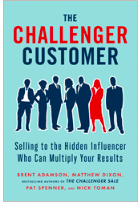 The issue, according to CEB’s research underpinning their new book The Challenger Customer, is that our improved ability to increase a buyer’s awareness of those areas of a solution most relevant to them, has inadvertently increased visibility into the overall risks associated with the purchase decision and/or change. As a result, buyers begin to unbundle and simplify solutions, driving down price points. The shocker of this insight is that marketers improved ability to personalize content may be coming at a cost to sales.
The issue, according to CEB’s research underpinning their new book The Challenger Customer, is that our improved ability to increase a buyer’s awareness of those areas of a solution most relevant to them, has inadvertently increased visibility into the overall risks associated with the purchase decision and/or change. As a result, buyers begin to unbundle and simplify solutions, driving down price points. The shocker of this insight is that marketers improved ability to personalize content may be coming at a cost to sales.
According to co-author, Pat Spenner, the real challenge lies in convincing buyers to first agree on making a change. “Focus your content marketing efforts on creating a consensus case for change among the decision making group,” which according to CEB’s research, now involves at least five people in the typical B2B purchase.
According to Spenner, “personalization can hurt the buyer’s ability to get that critical early consensus, because it can cement those individual stakeholders into their individual contexts, without doing anything to bring that more diverse group together around a common vision for change.”
So should we stop personalizing our communication? No, but it does highlight the need to also create that common rallying point, and to equip key buying group stakeholders with the tools to create consensus around it. Something the authors say helps clients elevate the conversation from “me to we,” an umbrella approach that ties your content efforts together regardless of the audience being targeted.
To motivate buyers to change you first have to disrupt their status quo by planting and nourishing seeds of doubt about “business as usual.” Show them not just the benefits of action, but the consequences of inaction. CEB recommends using fact-based content built off a Commercial Insight to break down buyers existing mental models.
Concurrent with breaking down the audience’s long held beliefs, you need to give them something to aspire to — a new future state that rallies the group to take action. This is where a compelling creative campaign does the heavy lifting. A “big play” campaign, like IBM’s “Smarter Planet” creates a compelling future vision but also provides a broad platform to disrupt IBM’s many different buyers and to cover IBM’s expansive solution/product portfolio.
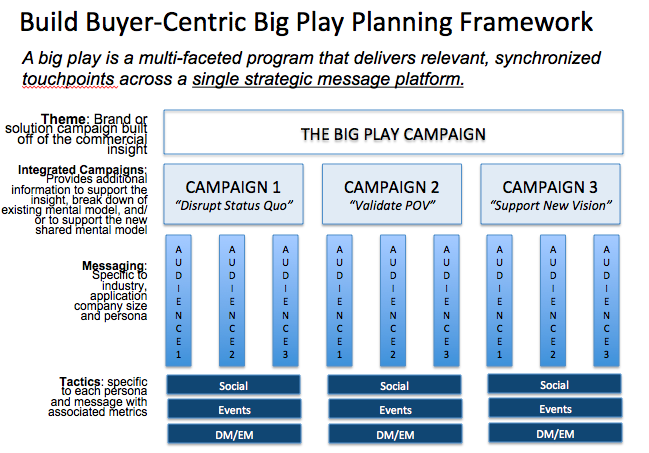
Personalization is still essential, and comes via messaging to specific audiences, but it is built on the commercial insight, and aligned to the common vision of the future state. It’s not that personalization doesn’t work, in fact, it can be very effective for breaking the status quo,” according to Spenner, “but you also need an unifying rallying point for buyers who may be too attuned to the risk associated with change.”
The key to leveraging the good work marketers have done to increase relevancy with buyers? Properly balance and/or convince the audiences that the rewards associated with making the change, both organizationally and personally, outweigh the risks you’re asking them to take on. If not, they will reduce the risk for you, and you may be hearing about it from sales.
by scott.gillum | Jul 29, 2015 | 2015, Observations
This year’s Fortune Brainstorm Tech conference in Aspen was an incredible experience.
 There were fantastic insights dropped by speakers like Rahm and Ari Emanuel, John Doerr from Kleiner Perkins Caufield & Byers, Reid Hoffman, CEO of Greylock Partner and co-founder of LinkedIn. I came away from the two and half-day event with three “ah-ha’s” because of their potential impact as game changers for marketers.
There were fantastic insights dropped by speakers like Rahm and Ari Emanuel, John Doerr from Kleiner Perkins Caufield & Byers, Reid Hoffman, CEO of Greylock Partner and co-founder of LinkedIn. I came away from the two and half-day event with three “ah-ha’s” because of their potential impact as game changers for marketers.
The New Native Advertising
Consumers are interacting with brands nearly all of the time. In the past, no one was watching and no one really cared, but new digital platforms and big data companies are about to change that. Companies like Storehouse, are giving consumers a platform to tell and share their story, many of which involve brands. Organizations like Ban.jo are capturing those moments and are beginning to alert brands. This “new native advertising” will grow out of naturally occurring brand experience that quickly get amplified and shared with others — real people, experiencing real brands, in real time. As this trend evolves, look for the role of the agency to shift from that of being the creator of disruptive ads aimed at getting your attention to amplifier and distributor of consumer generated organic ads.
Smart Carts
Jet.com recently launched to bring club discount shopping online. Its innovative business model is built off of the “smart cart.” As consumers fill up their cart, the price of the items begins to change based on availability of the item and the shipping location. Jet.com sources items from small business and tries to fill orders from local merchants. For example, you buy a baseball and a bat; you’ll get one price, add a baseball mitt and it will change the price for all three items depending on what type of mitt you are buying. To get the best price, wait a couple of days for shipping. Buy it immediately, and you’ll pay another price. Jet.com promises savings of 10-15 percent by using the advantage of filling orders locally and then passing the shipping cost savings along to the consumer.
The Internet of Things
Connected cars are coming. Actually, you could argue that it arrived years ago with GM’s OnStar. The next evolution later this year will include apps, beacons and commerce platforms like Visa Checkout and Apple Pay. Order a pizza from the Pizza Hut app on the screen in your car and payment processes automatically. Pull into the specially marked space in front of the restaurant and a beacon alerts them you have arrived for pickup. It also verifies your identity confirming payment. As beacons and autos unite, companies must begin to find ways for that 5-8” screen in your car to be the next big opportunity for advertising. 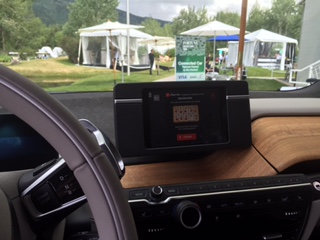
The most mind-blowing thing I saw or heard, though, is Ban.jo. Founded by Damien Patton, the company is what Inc. magazine describes as the “The Most Important Social Media Company You’ve Never Heard Of.” Ban.jo, by mining social media, can figure out what is happening anywhere in the world in real time by looking at a specific place at a specific time. Ban.jo was the first to detect the Boston Marathon bombing, the Ukrainian plane downing and even the Amtrak train wreck in Philadelphia. According to Patton, they beat traditional media organizations to the story by eight minutes on average.
Here’s the mind-blowing part: Ban.jo has built a virtual grid of more than 25 billion squares as an overlay of the entire globe. Their software monitors geo-located social posts for anomalies and then flags them for further investigation. It is, as Damien describes, “a crystal ball.” For marketers, it presents an opportunity to help facilitate the new native advertisement I mentioned above.
 Overall, the event was one of the most insightful conferences I’ve ever attended. From the location (Aspen) to the speakers, the event had a certain energy unlike any other event. It could be because of the amount of start-ups and investor present, but I believe it came from the attendees themselves. I met interesting people from fascinating companies who had a shared goal of meeting people and gaining knowledge. If you have the opportunity, put this in your budget for next year and book this event. I highly recommend it
Overall, the event was one of the most insightful conferences I’ve ever attended. From the location (Aspen) to the speakers, the event had a certain energy unlike any other event. It could be because of the amount of start-ups and investor present, but I believe it came from the attendees themselves. I met interesting people from fascinating companies who had a shared goal of meeting people and gaining knowledge. If you have the opportunity, put this in your budget for next year and book this event. I highly recommend it
by scott.gillum | Jun 24, 2015 | 2015, Marketing
 John Grant, author of The New Marketing Manifesto, states that, “Authenticity is the benchmark against which all brands are now judged.” If being authentic is that important, why has it been done so poorly by so many? If honesty and trust are foundation elements for building authentic brands, shouldn’t it be easy?
John Grant, author of The New Marketing Manifesto, states that, “Authenticity is the benchmark against which all brands are now judged.” If being authentic is that important, why has it been done so poorly by so many? If honesty and trust are foundation elements for building authentic brands, shouldn’t it be easy?
Business marketers often site issues relating to creating a consistent experience and message across the organization and/or across channels, staying true to the organization’s origins, and/or delivering on brand/product promises. All valid reasons, but perhaps there is another challenge at the core that goes unnoticed, something that inhibits the organizations ability tobe “real.” Aproblem simple in form, but difficult to detect and correct.
Yes, it is the senior executives, marketers, sales folks and service people themselves. The employees, who as humans, are uniquely influenced, and some may say flawed, by their own perceptions, bias, and motivations. Here are a few flaws that inhibit an organizations ability to be authentic:
- Biased views – research has found that executives, for better or worse, create “business personas” and view the world with that “business hat” on. In some ways, we play a “role” at work that fits a title, area of responsibility, or how others view you, that may not be realistic. Are we being fake? Maybe, maybe not, but if we say one thing, and believe something else that may be at odds with our “persona,” we just might be. It’s phenomenon researchers have observed with consumers their actions don’t necessarily match their words. In the business world, we act in a similar manner and may not realize that we are not being completely honest with ourselves, or with our customers…but they know.
- Refusing to recognize or accept change – customer preferences shift, markets fluctuate, competitors enter and exit, and companies evolve. One of the few certainties in business is that change is a constant. The problem is that many organizations are slow to recognize and react to a change. Even worse they flat out ignore it. As a result, companies continue to live in the past, or recognize the need for change and try to shift overnight. Authenticity involves an emotional connection with an audience and that connection is forged over years through consistency. Consistency builds trust and integrity. Ignoring the reality of your audiences’ world, trying to be something you’re not, or telling customers what you think they want to hear, quickly deteriorates trust and erodes integrity. “Keeping it real” involves keeping your head out of the sand and on the lookout for change, for better or worse. It also involves accepting reality as it is, no matter how painful it might be.
- The need for control – trust is a foundation element, and when we feel like it is lacking it sets off a basic human reaction to seek control over a situation. Inversely, when we trust, a handshake, for example, will often do look at the rise of shared economy companies like Uber, Airbnb. For established companies, take a look at the ever-expanding legal language in contracts and evaluate the impact it might be having on eroding trust with customers. In the business-to-business world, there are some situations where people have to trust each other to be successful and/or make progress. If we make it too complicated, we invite doubt and/or skepticism into the conversation making it difficult to create the foundation for a long-term relationship. Additionally, if we have an established relationship with a customer keep an eye on contracting, service agreements, product delivery language, etc.
I’ve only a listed a few of the “flaws” that challenge companies, many more exist, but multiply these by the number of humans (employees) at your company, and the number of channels an audience has to interact with your brand, and you begin to get a sense of the complexity of business marketing.
How do successful companies do it? How do they create and maintain an authentic message, perception, and/or brand, by building and preserving a strong corporate culture, but allowing for flexibility. As Bill Breen writes in Fast Company “To maintain its integrity, a brand must remain true to its values. And yet, to be relevant—or cool—a brand must be as dynamic as change itself.” Or as Shakespeare might say: “To thine own self be true.”
by scott.gillum | May 11, 2015 | 2015, Marketing
Look at the tweet, then read the graphic. Why is the headline on this tweet by Spencer Stuart, “Majority of marketing leaders want to see data-and analysis driven decision marketing on their teams,” and not “Majority of marketing leaders want to see more creative thinking and exploration on their teams?”
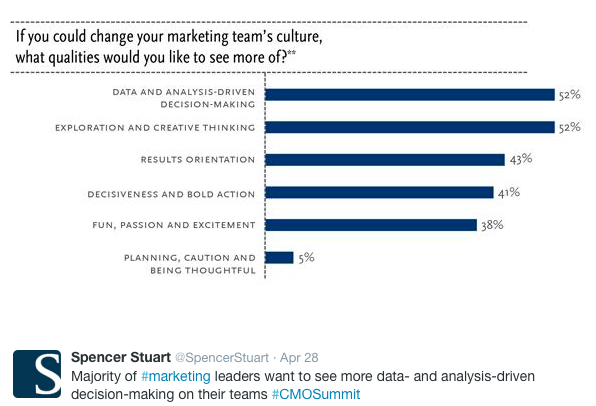
Statistically they’re the same, yet Spencer Stuart emphasized the data/analytic decision making why? “Combine Fun, Passion and Excitement” with “Decision and Bold Action” and you have a solid argument for changing the marketing team’s culture to “Exploration and Creative Thinking.”
On the flip side, only 5% of marketing wants a culture of “Planning, Caution and Being Thoughtful,” amen brother. Ok, I hear you, “if it was “fun” they would call it “play” not work, but maybe we need a little more play at work.
According to Peter Gray, a professor at Boston College and author of Free to Learn, ”play” can be the key that unlocks the mindset of bold creative thinking. In an article on Psychology Today, Gray says that the “alert but unstressed condition” of a playful mind has been shown repeatedly, in psychological experiments, to be ideal for creativity and learning new skills.
“Experiments have shown that strong pressure to perform well (which induces a non-playful state) improves performance on tasks that are mentally easy or habitual for the person, but worsens performance on tasks that require creativity, or conscious decision making, or the learning of new skills.” Although accountants may perform well under pressure, it could be a creativity killer for marketers.
One could conclude then, if an organization too narrowly focuses on “analysis and data driven decision making,” it may come at the expense of “Exploration and Creative Thinking” mentioned in the research and Tweet. Said differently, all work and no play, could make your marketers dull.
Pressure to perform in business marketing is a given, so how do you strike a healthy balance? Stephanie Anderson, CMO of Time Warner Cable’s business division, suggested that by ” focusing on business results first, ensuring that you have a way to show the business impact of marketing activities, you’ll have the foundation in place in order to inject a fun and creativity into the workplace.”
by scott.gillum | Mar 30, 2015 | 2015, Tech Trends
Last week I had the opportunity to attend two conferences that spanned the horizon of marketing. I went from “hoodies” at SXSW to “blue blazers” at the Institute for the Study of Business Markets (ISBM) Winter Member Meeting

Attendees at SXSW Interactive were young digital marketers, at the early stage of their careers. The ISBM crowd was comprised of mostly senior-level executives with 20 to 30 years of experience working for established companies.
Below are some insights from both of the events:
- Marketing is a tech wonderland. I had the chance to wander the event floor at SXSW, marvel at all of the new technologies, play with new apps, as well as attend a couple ofsessions by new tech vendors. The theme of the ISBM event was Analytics & Analysis, and I got more than my fair share of data analytics, business intelligence, econometric modeling … you name it. If you still think that half of your marketing budget is wasting away, but you don’t know which half, you’re behind the times.
- Analytics and dashboards are foundational. I saw a great presentation by Dell, which showed how the company has now mapped buyers across the buying process, complete with understanding their needs, time spent at each stage and how to optimize the experience. Likewise, Wesco and Teradata shared a wonderful journey of how Wesco put into place the tools needed to become a data-driven marketing group, enabling the company to tie its activities to business outcomes, or in this case, revenue. From what I heard and saw, companies have built the foundation to pull, analyze and report marketing performance data. Some have even made the leap into forecasting and predictive modeling.
- Investment is still a challenge. A thread ran through the ISBM event concerning the challenge of securing the funding to buy new marketing tools and/or staffing teams. Despite several speakers presenting solid case studies with clear ROIs, they were still challenged with getting the support and funding needed to continue making progress.
After having time to digest the week’s sessions, I still had a few lingering questions in my mind concerning what I heard and saw. For example:
- Is there a lack of organizational acceptance and/or appreciation of marketing insight and activities? The question that popped into my head regarding the funding challenge was, “Are marketers able to make the business case in a way that makes executives want to fund their request?” The other issue was marketing’s ability to communicate effectively across the organization based on it
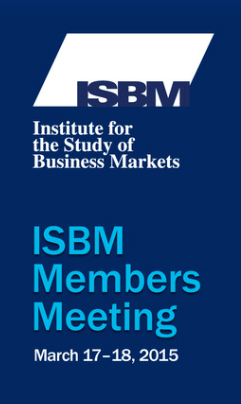 s culture. One speaker, Bill Rozier from Ciena, provided insight into how to do it effectively. Bill created a lead generation report in an easy to understand PowerPoint slide. As Bill said, “The sales team has to be able to get all the information they need in 30 seconds or less, or we’ve lost them.” Since Bill’s new report launched less than two months ago, lead reconciliation rates have gone from 13 percent to over 70 percent.
s culture. One speaker, Bill Rozier from Ciena, provided insight into how to do it effectively. Bill created a lead generation report in an easy to understand PowerPoint slide. As Bill said, “The sales team has to be able to get all the information they need in 30 seconds or less, or we’ve lost them.” Since Bill’s new report launched less than two months ago, lead reconciliation rates have gone from 13 percent to over 70 percent.
- Is there, or will there be, a communication gap between the “Hoodies” and “Blue Blazers”? It’s not necessarily a generational one, although there is that. Rather, it’s one based on what they view to be important and valuable. I saw some great social media tools at SXSW that provided deep insights into audience engagement and buyer intent. But close to half the marketing executives at the ISBM meeting had revenue targets, and almost all had lead targets. It made me think that there may be, or may soon be, a potential communication issue between the digital-savvy “engagement and intent” crowd and the “lead and revenue” veterans. From what I saw, there is still work to be done to close the gap between social media results and the connection to key performance metrics valued by marketing executives.
- Will marketing overplay analytics? Perhaps my biggest concern reflecting on the week is twofold. In business-to-business companies with strong product (and engineering) cultures that are empirically driven, will the utilization and reliance on new marketing tools and data limit an organization’s creativity, and/or innovation? The second concern has to do with organizations where marketing feels like they are under attack. Will marketers use their new reporting capabilities as a defense mechanism, hiding behind the data, instead of using it proactively to provide the organization with new insights and opportunities?
Despite these and other questions still weighing heavily on my mind, I did reach two solid conclusions. The first, Austin is by far the best food-truck town in the United States, and the second is that Tampa’s weather is the salve for the burn of the harsh Northeast winter — a point brought home to me as I returned from Tampa just in time for our first-day-of-spring snowstorm.
 The issue, according to CEB’s research underpinning their new book The Challenger Customer, is that our improved ability to increase a buyer’s awareness of those areas of a solution most relevant to them, has inadvertently increased visibility into the overall risks associated with the purchase decision and/or change. As a result, buyers begin to unbundle and simplify solutions, driving down price points. The shocker of this insight is that marketers improved ability to personalize content may be coming at a cost to sales.
The issue, according to CEB’s research underpinning their new book The Challenger Customer, is that our improved ability to increase a buyer’s awareness of those areas of a solution most relevant to them, has inadvertently increased visibility into the overall risks associated with the purchase decision and/or change. As a result, buyers begin to unbundle and simplify solutions, driving down price points. The shocker of this insight is that marketers improved ability to personalize content may be coming at a cost to sales.

 There were fantastic insights dropped by speakers like Rahm and Ari Emanuel, John Doerr from Kleiner Perkins Caufield & Byers, Reid Hoffman, CEO of Greylock Partner and co-founder of LinkedIn. I came away from the two and half-day event with three “ah-ha’s” because of their potential impact as game changers for marketers.
There were fantastic insights dropped by speakers like Rahm and Ari Emanuel, John Doerr from Kleiner Perkins Caufield & Byers, Reid Hoffman, CEO of Greylock Partner and co-founder of LinkedIn. I came away from the two and half-day event with three “ah-ha’s” because of their potential impact as game changers for marketers.
 Overall, the event was one of the most insightful conferences I’ve ever attended. From the location (Aspen) to the speakers, the event had a certain energy unlike any other event. It could be because of the amount of start-ups and investor present, but I believe it came from the attendees themselves. I met interesting people from fascinating companies who had a shared goal of meeting people and gaining knowledge. If you have the opportunity, put this in your budget for next year and book this event. I highly recommend it
Overall, the event was one of the most insightful conferences I’ve ever attended. From the location (Aspen) to the speakers, the event had a certain energy unlike any other event. It could be because of the amount of start-ups and investor present, but I believe it came from the attendees themselves. I met interesting people from fascinating companies who had a shared goal of meeting people and gaining knowledge. If you have the opportunity, put this in your budget for next year and book this event. I highly recommend it John Grant, author of
John Grant, author of 

 s culture. One speaker, Bill Rozier from Ciena, provided insight into how to do it effectively. Bill created a lead generation report in an easy to understand PowerPoint slide. As Bill said, “The sales team has to be able to get all the information they need in 30 seconds or less, or we’ve lost them.” Since Bill’s new report launched less than two months ago, lead reconciliation rates have gone from 13 percent to over 70 percent.
s culture. One speaker, Bill Rozier from Ciena, provided insight into how to do it effectively. Bill created a lead generation report in an easy to understand PowerPoint slide. As Bill said, “The sales team has to be able to get all the information they need in 30 seconds or less, or we’ve lost them.” Since Bill’s new report launched less than two months ago, lead reconciliation rates have gone from 13 percent to over 70 percent.




